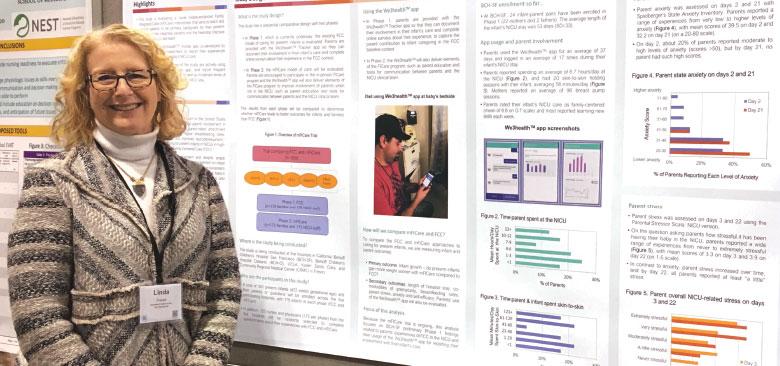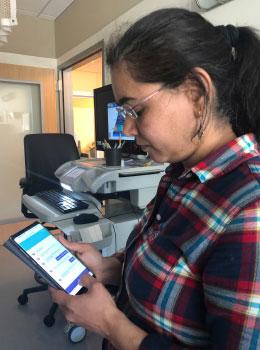
Linda Franck in front of a poster presentation for mFICare.
A Conversation with Linda Franck: Helping Preterm and Low-Birth-Weight Babies Survive and Thrive
Linda Franck holds the Jack & Elaine Koehn Endowed Chair in Pediatric Nursing at UC San Francisco School of Nursing and is co-principal investigator on UCSF’s California Preterm Birth Initiative (PTBi-CA). She is also a co-author on Survive and Thrive: Transforming Care for Every Small and Sick Newborn, a report commissioned by UNICEF and the World Health Organization (WHO), with support from partners including the United States Agency for International Development (USAID), Save the Children and the Bill & Melinda Gates Foundation. In late 2018, she also contributed to a brief on the essential role of family participation in the care of inpatient newborns, published by the global USAID-supported group Every Preemie–SCALE.
What is the significance of the Survive and Thrive report?
For the global community to meet the United Nations’ Sustainable Development Goals for health, we all need to focus on babies who are born too soon or too small and do something bigger and bolder than what we’ve been doing. Survive and Thrive is more than a call to action – it’s a call to increase the urgency of action for supporting these babies and their parents across the continuum of care.
Until now, we have never fully articulated newborn health care standards at all levels – country, facility, community and family – or clearly explained how the standards contribute to quality and safety. The standards and supporting strategies are important across the world, in both high- and low-resource settings, particularly to address inequities in access to care and quality of care. For the first time, these standards explicitly describe the crucial role of the family in the care of preterm and low-birth-weight infants.
Having prominent organizations people and experts signing on to Survive and Thrive creates positive pressure for change and increases the likelihood that decision makers will aim to meet the standards and redirect resources where needed.
What was the importance of the Every Preemie–SCALE brief?
The brief emphasizes the essential role of families in inpatient newborn care. Including parents is not just something you do when you don’t have enough nurses, and it means more than just assigning parents a few tasks; they need to be part of shared decision making as well. At UCSF, we are conducting research on how parents can be effective partners in the care of preterm infants, with the Mobile-enhanced Family Integrated Care [mFICare] project, because having evidence of effectiveness is an essential part of changing policy and practice.
Family-centered care is a perfect example. We’ve created a body of evidence that offers a firm foundation for standards that elevate the role of the family. It’s both an honor and an obligation to participate in these bigger efforts.
What exactly is family-integrated care?
Family-integrated care [FICare] is a model of care that transforms the culture of the NICU [neonatal intensive care unit] by training and supporting parents to be their baby’s primary caregiver and full partners in their baby’s NICU care team. At six sites – UCSF Benioff Children’s Hospitals [San Francisco and Oakland], Fresno [Community Regional Medical Center] and UCLA Santa Monica, UC San Diego and Kaiser Santa Clara – PTBi-CA is leading the first U.S. study of a mobile-enhanced version of FICare.
 A parent uses the mFICare app (photo by Katie Millar). Our work is based on a successful Canadian FICare model, but we’ve included families who can’t be in the NICU continuously, by connecting them remotely through an app that we co-developed with parent partners and the parent-led Will’s Way Foundation. The app also allows us to collect better data about what’s going on in family-centered care. It helps us understand how much kangaroo care [skin-to-skin care, an essential piece of reducing infant stress] parents are able to do, as well as their level of stress and anxiety across the hospitalization. Parent anxiety and stress really matter in the NICU, because if they are very stressed, that can be a barrier to their involvement in their baby’s care. Essentially, we are following the emotional journey of the family to understand what interventions we need to do, including what parents need to know and when. One of our dreams with the app and the family-partnered research network we’re building is to get a large enough database that we can do machine learning to enable more sophisticated and tailored teaching and support for families. We should be able to do for parents of sick babies what online search engines and retailers do for consumers – offering them curated choices based on their needs and preferences.
A parent uses the mFICare app (photo by Katie Millar). Our work is based on a successful Canadian FICare model, but we’ve included families who can’t be in the NICU continuously, by connecting them remotely through an app that we co-developed with parent partners and the parent-led Will’s Way Foundation. The app also allows us to collect better data about what’s going on in family-centered care. It helps us understand how much kangaroo care [skin-to-skin care, an essential piece of reducing infant stress] parents are able to do, as well as their level of stress and anxiety across the hospitalization. Parent anxiety and stress really matter in the NICU, because if they are very stressed, that can be a barrier to their involvement in their baby’s care. Essentially, we are following the emotional journey of the family to understand what interventions we need to do, including what parents need to know and when. One of our dreams with the app and the family-partnered research network we’re building is to get a large enough database that we can do machine learning to enable more sophisticated and tailored teaching and support for families. We should be able to do for parents of sick babies what online search engines and retailers do for consumers – offering them curated choices based on their needs and preferences.
Another piece of technology we’re excited about is wireless temperature monitoring for babies. One of the reasons babies don’t receive more kangaroo care is that nurses have to unwrap the babies often to check their temperature with a handheld probe designed in the 1990s, which can stress babies, and they may even get cold – which defeats the purpose of kangaroo care. We are working with engineers at UCSD to develop a small, adhesive-embedded thermometer that can be gently attached to the baby and monitored remotely. This would be a huge improvement over current practice.
Wireless temperature sensors and mFICare are two of the many projects in the PTBi-CA portfolio. What else is new in the initiative?
We have made progress in multiple ways that, we believe, validate our unique research model. When we began PTBi, there was already a lot of work going on in the field, but little progress had been made, so we’ve tried to do our research differently. One of our principles is to work in close partnership with the communities and individuals most affected by preterm birth, bringing them in as full research partners to help formulate the questions and shape what and how we do our research work. In California, these partnerships are critical if we are to address the huge disparities in preterm birth rates among different racial and ethnic groups. This has led us to focus in on the role of structural racism and its connection to chronic stress as a major driver of preterm birth in California and the U.S.
For example, we have a very active Community Advisory Board and NICU Parent-Clinician Advisory Boards, and many of the members are women of color who have experienced preterm birth. In addition to helping to shape our own research agenda, they have been instrumental in our grant-giving program. So far, we have awarded more than $2.5 million in research grants to UCSF-affiliated research teams. Our Community Advisory Board and Parent-Clinician Advisory Boards help shape our requests for proposals and evaluate the research applications. I think that this formal mechanism for community review of research proposals and for guaranteeing a community voice into research agenda setting is pretty revolutionary. The board members are “experts by experience,” and their wisdom has been invaluable in all aspects of our work. They also play an important role in the community by explaining how our research work might inform an issue the community cares deeply about. That kind of partnership builds trust between UCSF and our local communities.
What are some examples of work that has emerged from this approach?
Our SOLARS [Supporting Our Ladies and Reducing Stress to Prevent Preterm Birth] project, conceived by Monica McLemore and now co-led by Laura Jelliffe-Pawlowski and Brittany Chambers, is an intensive longitudinal study aimed at understanding how racism, intimate partner violence, pregnancy-related anxiety and other chronic stressors affect biological pathways to impact gestational duration and preterm birth. Past studies usually focused only on one dimension – either the biological, the psychological or the environment – but [McLemore’s] novel pilot work showed that respecting and integrating women’s questions and needs into study design can lead to women enthusiastically participating in a study that requires a lot of effort from them – because they want the answers too. Now we have launched the full study of 500 women in Oakland – with a research team that is largely from the community – and we believe this study will uncover the links among personal experience, the environment and women’s biology and ultimately lead to better ways to predict and prevent preterm birth.
Similarly, in our Glow! trial, in Fresno, we have worked very closely with women in that community to create a demonstration project of group prenatal care with wraparound support services for pregnant women, as well as supports for providers to make it more feasible to offer group prenatal care to their clients. If we find that this package of interventions is feasible, we should be able to improve the rates of preterm birth and the outcomes for infants born too soon or too small.
Another thing that’s been really exciting is our Collective Impact effort, which tests the hypothesis that cross-sector partnerships and system-level change can reduce the rate of preterm birth and address persistent disparities. In Fresno and San Francisco, we’ve brought mothers with lived experience of preterm birth and leaders in health care, social services, education, business, transportation and others to the same table to learn about the problem and discuss how we can align and develop different ways of working together to tackle this problem. An example of the power of this approach is how San Francisco’s effort, called Expecting Justice, was instrumental in securing funding through different sources to provide a doula for every pregnant African American and Pacific Islander woman in San Francisco; they are the women most at risk for preterm birth and poor outcomes in the city.
Through these projects and many others, we are hopeful that we are building a movement that brings people on board who are passionate about reducing health inequities and willing to take on the preterm birth challenge. We have learned so much already and are already starting to see the positive impact of this new approach to research.



